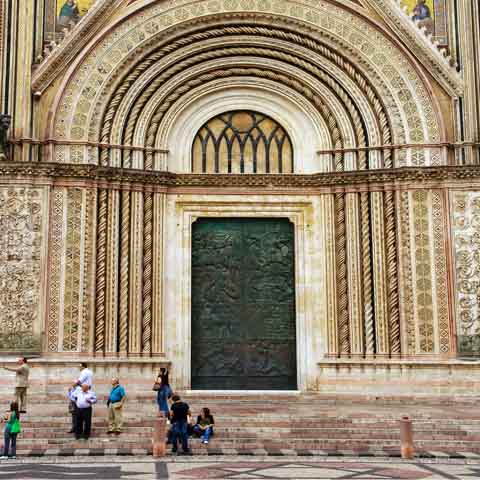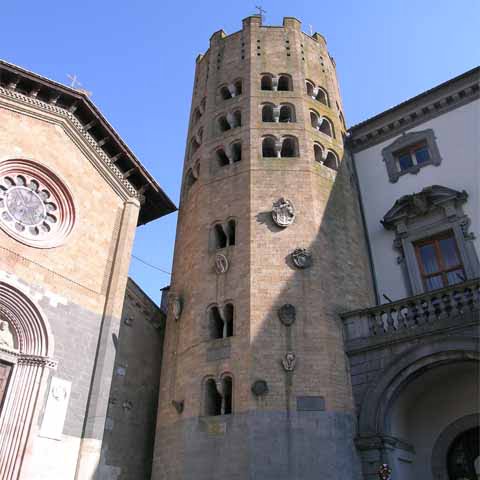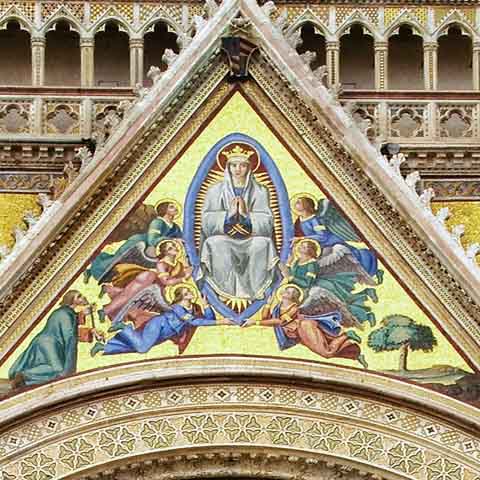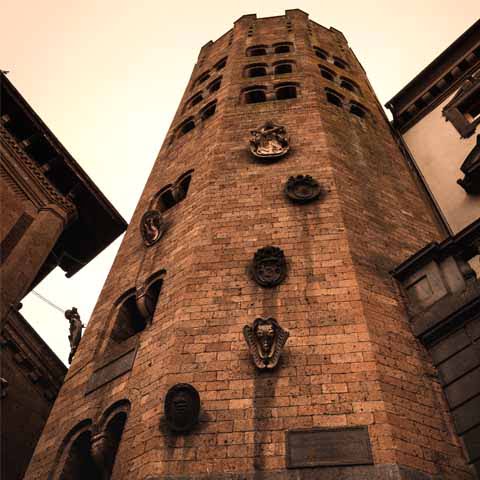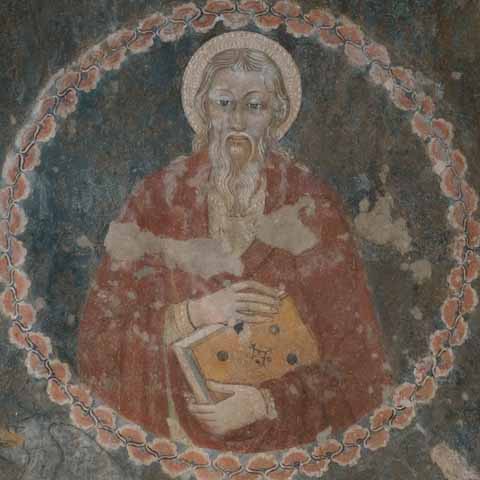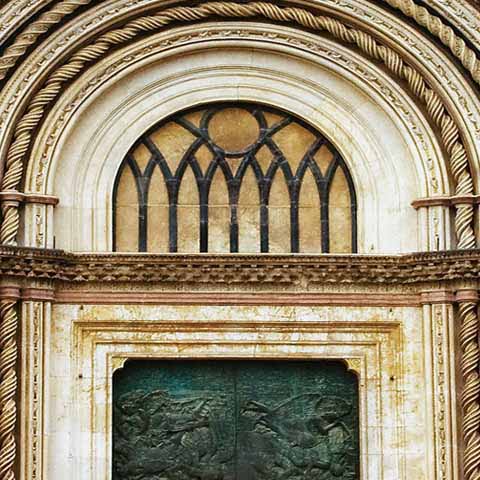Orvieto is one of the most charming towns in Italy, settled on a cliff overlooking the valley of the Paglia River.
The origins of Orvieto date back to distant times when the geological scenario characterizing the entire central part of the Italian peninsula was that of a large expanse of water scattered by portions of land emerging from the sea. These lands have always been renowned for their seismic activity, and it is believed that today’s territory of Orvieto is the result of volcanic activity.
In fact, scientists claim that the explosive pyroclastic activity and lava flow generated by the Bolsena volcanic complex led to the accumulation of magma, rock, and pyroclastic sediment, forming the plateau where Orvieto later grew.
At the same time, this intense volcanic activity poured out large quantities of magma, emptying the magma chamber of the volcano. It is easy to imagine the emptied chamber could only generate the collapse of parts of the volcano, resulting in a sinkhole depression which, over the years, gathered the water of Lake Bolsena.
Both the geological activity and erosive action of the water shaped the Orvieto cliff, giving it its characteristic aspect.
In this scenario, the land constituted a true attraction for the prehistoric civilizations. The natural environment consisting of green swampy areas and dense vegetation was favorable for agriculture and breeding.
Direct testimonies of the early colonization of the area are some fossils found in a cave at the base of the cliff.
The peculiar characteristic of the territory is the geological stratification of the land. The volcanic materials that make up the cliff have various consistencies, with some layers being more solid than others.
This peculiarity allowed earlier civilizations to shape the cliff and create cavities, ancient manmade caves, tunnels, and wells, used both as a shelter for people and places for breeding birds.
PREHISTORY OF ORVIETO
The early prehistory of Orvieto is shrouded in mystery, but it is certain that the settlement had great importance over the different historical periods. In the ninth century BC, the territory was colonized by the Etruscans, one of the most illustrious prehistoric civilizations.
Under their occupation, Orvieto experienced a period of great splendor, becoming one of the most important inhabited areas of the vast territory of Etruria. In the Etruscan era, the settlement was called Velzna, and it witnessed a unique and unrepeatable period of prosperity and development.
According to archaeologists and historians, the area below the cliff constituted the famous Fanum Voltumnae, the Temple of Voltumno. This sanctuary served as a gathering place for the periodic assembly of the Etruscan council, where the twelve sovereign cities of Etruria made decisions regarding their foreign policy, military actions, and elected the leader of the league, as well as performing religious rites and competing in games.
Although later edifices built over the Fanum destroyed much of its structure, archaeological excavations still managed to bring to light portions of the imposing temple, as well as further evidence of a Roman spa and a medieval church.
What is certain though is that the Etruscan civilization left many traces of their passage that are still evident in modern Orvieto.
Among the various findings, perhaps the most important is the necropolis Crocifisso del Tufo, built on the side of a cliff overlooking Orvieto Scalo. The remains of the Temple of Belvedere are another fascinating find.
Other testimonies include a precious collection of pottery and other Etruscan objects present in the various museums of the city.
Orvieto remained under the Etruscans for a long time, until the territory was invaded by the Romans. With the arrival of the troops of Rome, Orvieto was almost completely destroyed and looted, losing much of its prestige and maintaining only a marginal territory role.
Taking advantage of the weakened city, the lower class started to consolidate power through fervent uprisings. The Etruscan aristocrats secretly asked the Romans for help. Rome responded to their request and sent an army led by Quintus Fabius Maximus to the town.
What followed were bloody clashes that resulted in the death of the consul, thus provoking violent Roman repression. These events led to a long siege that ended with the destruction of Orvieto in 264 BC. Rome exiled and deported the few survivors to Volsinii Novi, today’s Bolsena.
Following the events, the cliff soon became depopulated and left to total abandonment, while the lower territories maintained a more active and vital role during the Roman domination, mainly thanks to the presence of the Paglia and Tiber rivers.
The Romans colonized almost all the countryside and built numerous villas. The territory became an important hub for the circulation of goods for both Rome and Ostia, mainly due to the presence of the Pagliano Port, constructed on the confluence of the Paglia and Tiber rivers.
Orvieto’s countryside also had an important role in the production and commerce of wine, oil, and terracotta.
Sadly though, there are only a few traces still visible of this Roman legacy. The remains of the original Roman bridge that was later rebuilt in medieval style at the behest of Pope Julius II can still be seen.
Noteworthy are also the remains of the Ponte delle Colonnacce bridge over the Paglia River and the remains of the river port.
HISTORY OF ORVIETO
With the end of the Roman Empire, Orvieto fell under barbarian domination; then the entire territory was left to abandonment until the early Middle Ages. During this time, Orvieto still saw the succession of brief dominations of various peoples.
From the early Middle Ages, the city began to be increasingly marked by the presence of the Pope and started to reassume a more significant role.
The town was still struggling with internal conflicts, but at the same time, it was consolidating as a free municipality. In 1157, a papal delegation signed a treaty with Orvieto, formalizing the investiture of the church in the region, and in 1199 the Pope chose the first rector and Podestà of Orvieto in the figure of Pietro Poreche, a Roman nobleman.
This event marked the “subjugation” of the Umbrian city to the papacy. The link with the church gave new impetus to the development and prestige of the town while still nourishing never-ending internal conflicts between various factions and noble families.
Perhaps the most famous rivals in the area were the Monaldeschi, belonging to the Guelph faction, and the Filippeschi, a family tied to the Ghibelline faction. In the background of these struggles, an anticlerical movement rose that involved conspiracies and murders.
However, these contrasts had little influence on the development and growth of the city, and at the beginning of the thirteenth
century, Orvieto became a modern city-state, experiencing a period of great prosperity and expansion.
The surrounding territories were not optimistic about this expansion, although Orvieto expanded its borders up to the coast of the Tyrrhenian Sea, incorporating the cities of Talamone and Orbetello.
During this period, the city kept its Roman name of Urbs-Vetus, meaning old city, and from this term, the current name Orvieto was derived.
In this period of great splendor, Orvieto distinguished itself in the entire region thanks to excellent internal organization at the institutional and social levels, reflected in an orderly subdivision of the districts.
Thanks to a collective agreement between noble families and the church, the city also received numerous improvements, including the construction of many landmarks, such as the Duomo, Palazzo Comunale, Palazzo del Popolo, fountains, and other important edifices.
These interventions involved the three main squares of the city, delineating the importance of three social elements; the Duomo and its square representing religious power, Palazzo del Popolo and its relative square representing the people, and Palazzo Comunale together with Piazza della Republica representing political power.
Sadly, this period of glory and prosperity came to an end in 1348 when a plague epidemic hit the city. The great noble families then started to become involved in more internal struggles, putting an end to the city-state period.
Orvieto fell under the protection of the Papal States, and after the intervention of the papal troops led by Albornoz in 1354, it became a real refuge and place of protection of the popes who fled from Rome after the invasion of the Landsknechts.
From then on and up to the end of the eighteenth century, Orvieto underwent profound transformations from an architectural point of view, including the reconstruction of the Albornoz Fortress, the construction of the famous Pozzo di San Patrizio, and numerous other restorations.
At the same time, the city also witnessed the construction of noble Renaissance palaces that still embellish its streets.
Orvieto’s rebirth and development was partly initiated by the presence of the high priests and pontiffs who consolidated and found impetus from 1860 on. In fact, in that year, Orvieto joined the Kingdom of Italy under the Savoy, becoming almost a border town between the former and the Papal States.
However, the annexation to the Kingdom of Italy provoked a rupture between the city and the Papal States, mainly due to the intervention of Filippo Antonio Gualtiero, an important minister of the Italian Kingdom. The minister gathered military forces in an attempt to fight clergy and their power.
The political affiliation of Orvieto to the Kingdom entailed the incorporation of new noble families into society. These families acquired many assets initially belonging to the Church, and in this climate of change, received a new social and economic impulse that laid the basis of new perspectives.
This era of profound renewal and new impetus of the city continued until the end of the nineteenth century. Over this time, the city witnessed new restoration work, including the edification of the dodecagonal bell tower of the Church of Sant’Andrea, as well as the completion of existing buildings and modernization of roads.
All these improvements intensified communication with the other areas of Italy. Public works also progressed in the rest of the territory, and Orvieto received its first funicular in 1888, a railway connecting the city with Rome, a new public aqueduct, and the commissioning of the hydroelectric plant designed to provide energy to the city.
This period of development also continued throughout the first half of the twentieth century with the construction of more public buildings and the connection of the city to the highway.
ARCHAEOLOGY IN ORVIETO
Orvieto has a rich history testified by numerous Etruscan and Roman remains. Perhaps the most noteworthy site from an archaeological point of view is Campo della Fiera, where the Federal Sanctuary of the Etruscans known as Fanum Voltumnae is located.
Numerous other vestiges scattered throughout the territory comprise both Etruscan and Roman remains, such as the Colonnacce Bridge over the Paglia River, the remains of the Port of Pagliano near the inhabited center, and some ancient Roman furnaces discovered in the area of Lake Corbara in the archaeological area of Scoppieto.
Although important from an Etruscan standpoint, Campo della Fiera also comprises significant Roman vestiges as well as some medieval remains. Of extraordinary importance are the ruins of a Roman Domus and some mosaics typical of thermal Roman baths, which indicate that the Romans might have transformed the sanctuary into a spa.
Besides these open-air sites, Orvieto also holds important evidence of the passage of the people in the National Archaeological Museum. Those interested in the Etruscan legacy can find a rich collection of artifacts at the Claudio Faina Etruscan Museum.
Travel Guides
The Umbria Region of Italy
The Cities of Umbria, Italy
